
Suspended: A Cryogenic Nightmare is an interactive fiction video game written by Michael Berlyn and published by Infocom in 1983. Infocom's sixth game, it was released for Amstrad CPC, Apple II, Atari 8-bit computers, Commodore 64, Commodore Plus/4, IBM PC compatibles, TRS-80, and TI-99/4A. It was later available for Mac, Amiga, and Atari ST.

A murder mystery game is a type of party game in which players investigate and solve fictitious murders. In many such games, a player secretly plays as a murderer while the others attempt to determine the murderer's identity.

The West Coast Computer Faire was an annual computer industry conference and exposition most often associated with San Francisco, its first and most frequent venue. The first fair was held in 1977 and was organized by Jim Warren and Bob Reiling. At the time, it was the biggest computer show in the world, intended to popularize the personal computer in the home. The West Coast PC Faire was formed to provide a more specialized show. However, Apple Inc. stopped exhibiting at the West Coast Computer Faire, refusing to exhibit at any show other than COMDEX that also had PC-based exhibits.

A character sheet is a record of a player character in a role-playing game, including whatever details, notes, game statistics, and background information a player would need during a play session. Character sheets can be found in use in both traditional and action role-playing games. Almost all role-playing games make use of character sheets in some fashion; even "rules-light" systems and freeform role-playing games record character details in some manner.
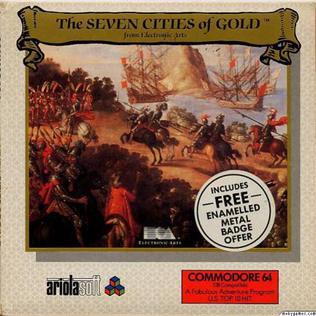
The Seven Cities of Gold is a strategy video game created by Danielle Bunten Berry and Ozark Softscape and published by Electronic Arts in 1984. The player takes the role of a late 15th-century explorer for the Spanish Empire, setting sail to the New World in order to explore the map and interact with the natives in order to win gold and please the Spanish court. The name derives from the "seven cities" of Quivira and Cíbola that were said to be located somewhere in the Southwest United States. It is considered to be one of the earliest open world video games.
The Print Shop is a desktop publishing software package originally published in 1984 by Broderbund. It was unique in that it provided libraries of clip art and templates through a simple interface to build signs, posters and banners with household dot-matrix printers. Over the years, the software has been updated to accommodate changing file formats and printer technologies.

The Bard's Tale II: The Destiny Knight is a fantasy role-playing video game created by Interplay Productions in 1986. It is the first sequel to The Bard's Tale, and the last game of the series that was designed and programmed by Michael Cranford.

Kiplinger's Personal Finance is an American personal finance magazine published by Kiplinger since 1947. It claims to be the first American personal finance magazine and to deliver "sound, unbiased advice in clear, concise language". It offers advice on managing money and achieving financial security, saving, investing, planning for retirement, paying for college, and major purchases like automobiles and homes.
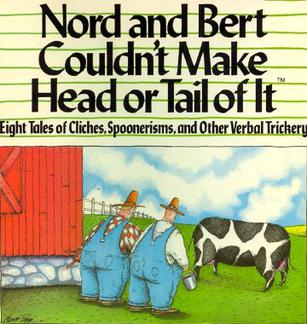
Nord and Bert Couldn't Make Head or Tail of It is an interactive fiction video game written by Jeff O'Neill and published by Infocom in 1987. It was released simultaneously for MS-DOS, Commodore 64, and other platforms. Nord and Bert was unique among Infocom games in that it used the game engine to present wordplay puzzles rather than an adventure story. It was Infocom's twenty-seventh game.
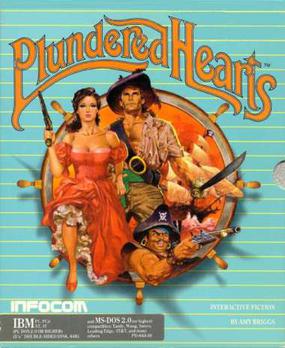
Plundered Hearts is an interactive fiction video game created by Amy Briggs and published by Infocom in 1987. Infocom's only game in the romance genre, it was released simultaneously for the Commodore 64, Atari 8-bit computers, Atari ST, Amiga, classic Mac OS, and MS-DOS. It is Infocom's twenty-eighth game.

Dennis Publishing Ltd. was a British publisher. It was founded in 1973 by Felix Dennis. Its first publication was a kung-fu magazine. Most of its titles now belong to Future plc.
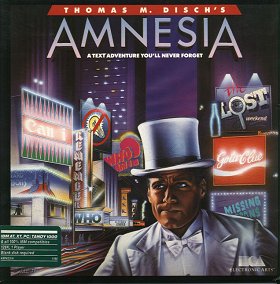
Amnesia is a text adventure written by science fiction author Thomas M. Disch and programmed by Kevin Bentley. It was published by Electronic Arts in 1986 for IBM PC compatibles and Apple II. A Commodore 64 version was released in 1987. Disch's ironic, rich writing style is in distinct contrast to the functional or tongue-in-cheek tone of most text adventures. Over half of Disch's novel-length manuscript had to be cut from the published version to fit on a 5¼" floppy disk.

Astrology software is a type of computer programs designed to calculate horoscopes. Many of them also assemble interpretive text into narrative reports.

Injured Engine is a game released for the Apple II and Commodore 64 by Imagic. The player must diagnose problems in a simulated automobile engine. The game aims to teach how engines work and how engine parts relate to each other. It was created by an auto mechanic and a graphic artist. Imagic demonstrated it at the 1984 Consumer Electronics Show.

Timex Datalink or Timex Data Link is a line of early smartwatches manufactured by Timex and is considered a wristwatch computer. It is the first watch capable of downloading information wirelessly from a computer. As the name implies, datalink watches are capable of data transfer through linking with a computer. The Datalink line was introduced in 1994 and it was co-developed with Microsoft as a wearable alternative to mainstream PDAs with additional attributes such as water resistance, that PDAs lacked, and easy programmability. The watch was demonstrated by Bill Gates on 21 June 1994 in a presentation where he downloaded information from a computer monitor using bars of light and then showed to the audience the downloaded appointments and other data. The early models included models 50, 70, 150 and model 150s. The model numbers indicated the approximate number of phone numbers that could be stored in the watch memory. These early models were, at the time of their introduction, the only watches to bear the Microsoft logo. The watches have been certified by NASA for space travel and have been used by astronauts and cosmonauts in space missions. There had been an evolution over the years as to the number and type of entries that can be stored in the various watch models as well as the mode of data transfer between computer and watch. At the time of its introduction the watch was considered high-tech.
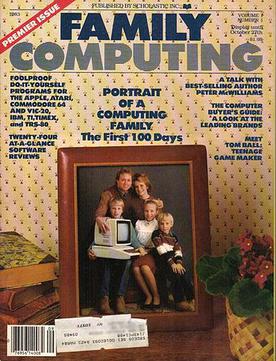
Family Computing was an American computer magazine published by Scholastic from the 1980s to the early 2000s. It covered all the major home computer platforms of the day including the Apple II, VIC-20, Commodore 64, Atari 8-bit computers, as well as the IBM PC and Macintosh. It printed a mixture of product reviews, how-to articles and type-in programs. The magazine also featured a teen-oriented insert called K-Power, written by Stuyvesant High School students called the Special-K's. The section was named after a former sister magazine which folded after a short run. This section was discontinued after the July 1987 issue as part of the magazine's shift toward home-office computing.

GBA Championship Basketball: Two-on-Two is a sports video game for IBM PC compatibles Amiga, Apple II, Apple IIGS, Amstrad CPC, Atari ST, ZX Spectrum, and Commodore 64. It was developed by Dynamix and published in 1986 by Activision.
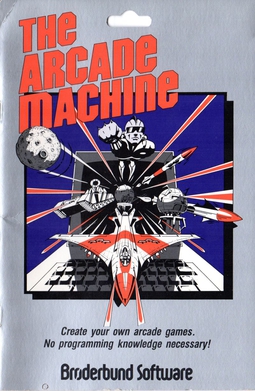
The Arcade Machine is a game creation system written by Chris Jochumson and Doug Carlston for the Apple II and published by Broderbund in 1982. Louis Ewens ported it to Atari 8-bit computers. Broderbund ran a contest from January–June 1984 where the best user-created game was awarded a prize of $1,500 in hardware and software. Jochumson also wrote Track Attack for Broderbund.

The American Challenge: A Sailing Simulation is a sailing simulation and racing game developed by Tom Snyder Productions and published by Mindscape in 1986. It allows two players to race online via modem.

How to Host a Murder: The Watersdown Affair is a murder mystery party game published by Decipher in 1985.



















